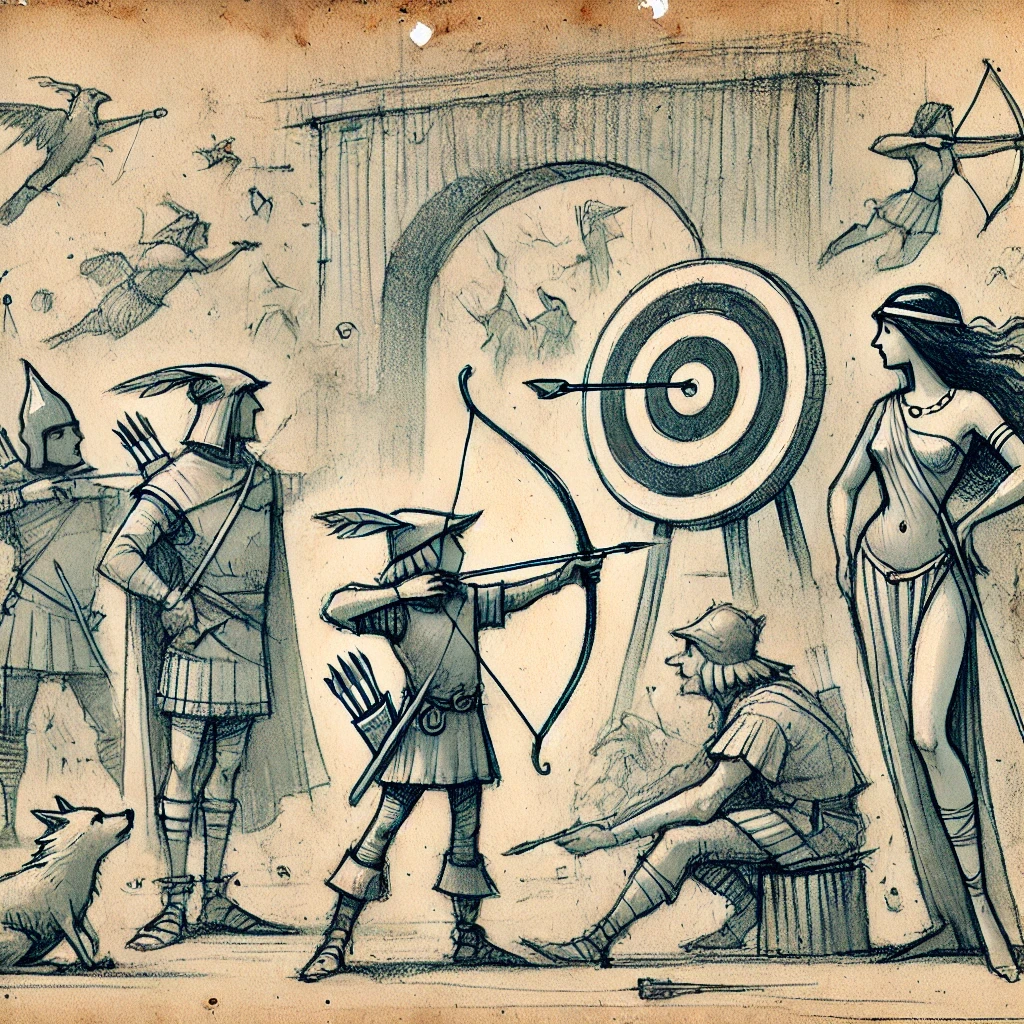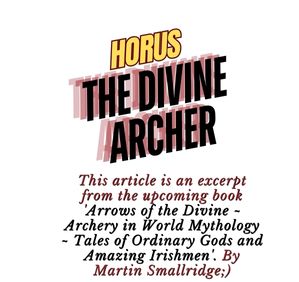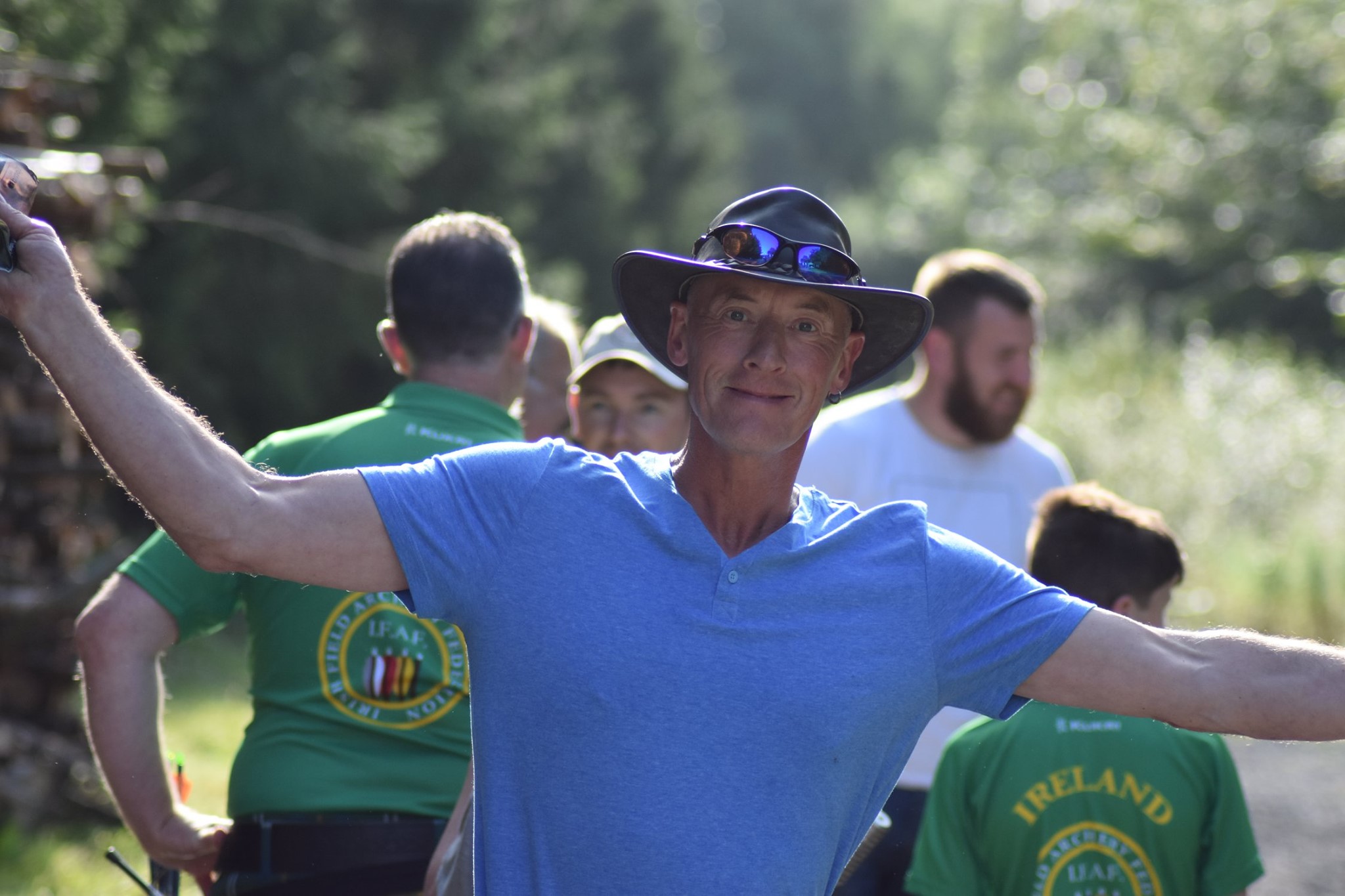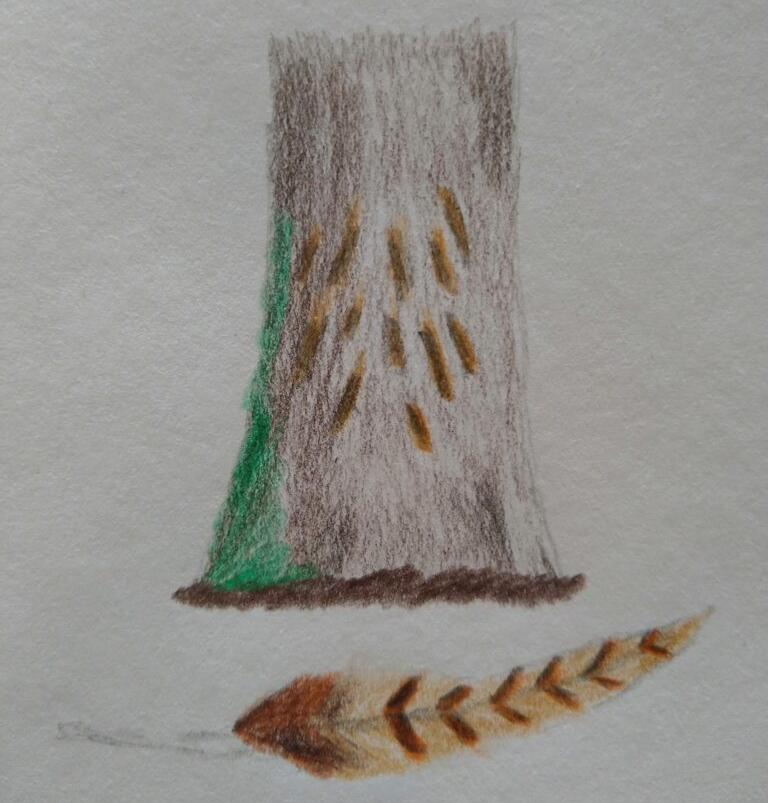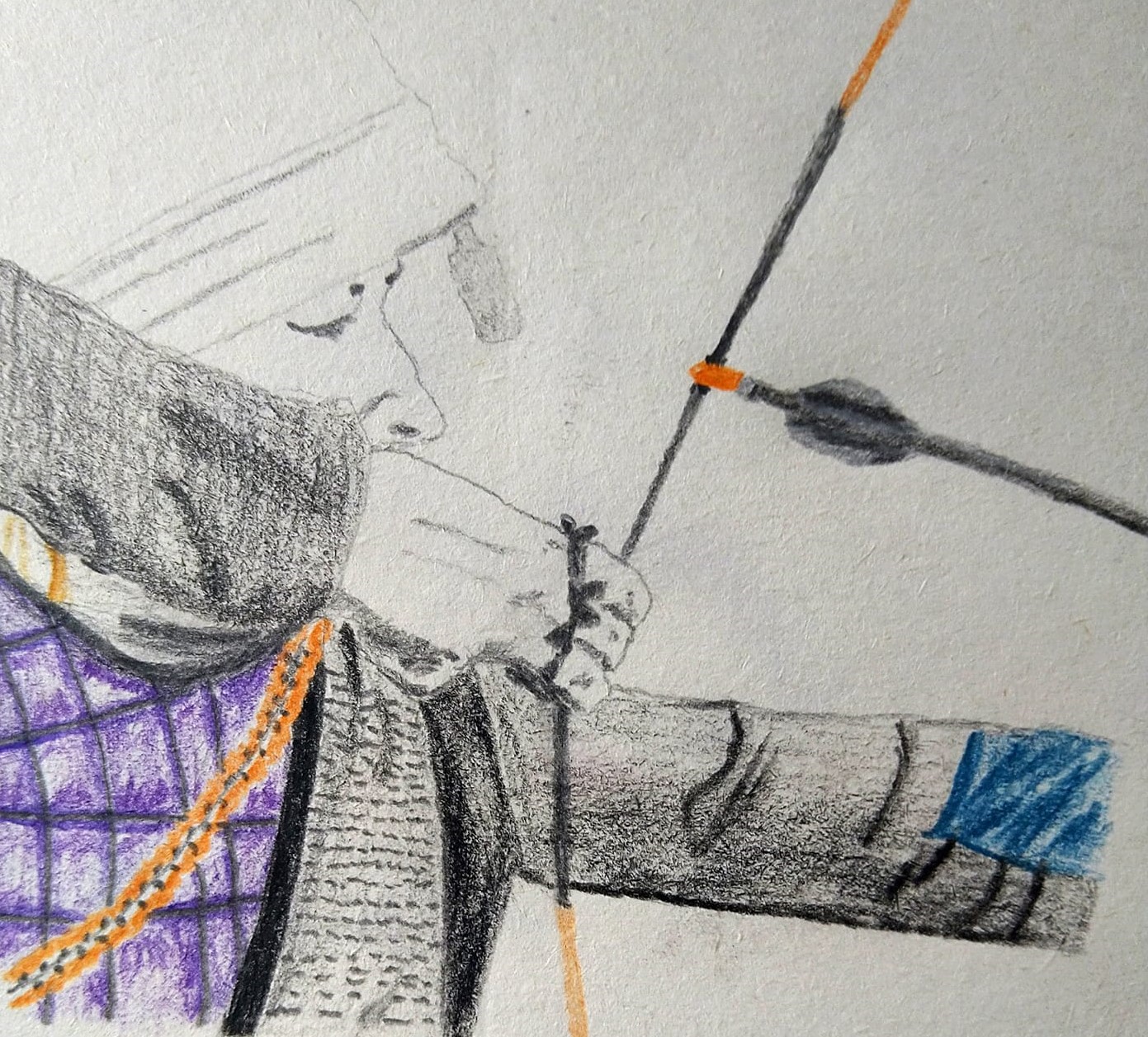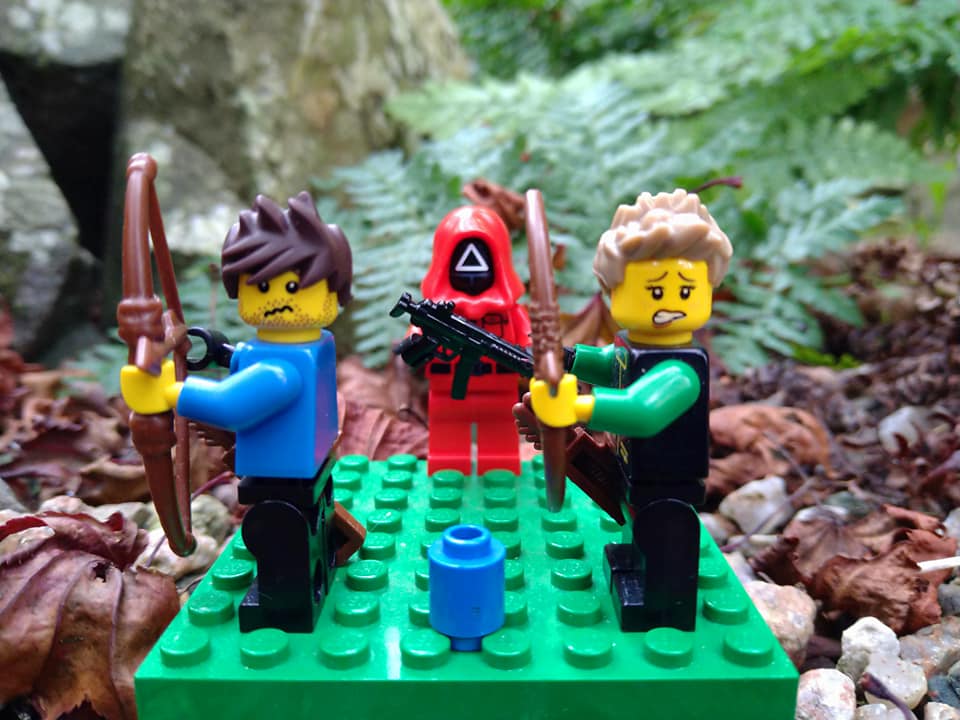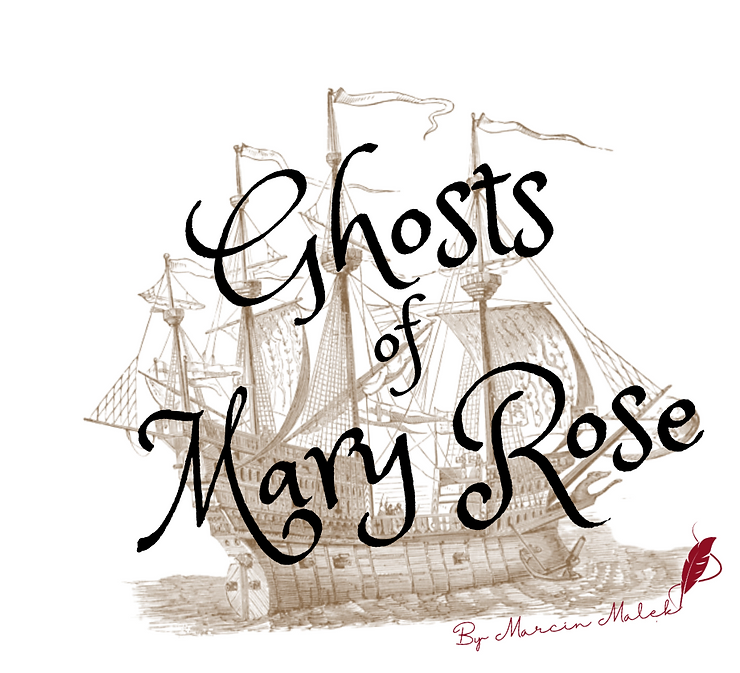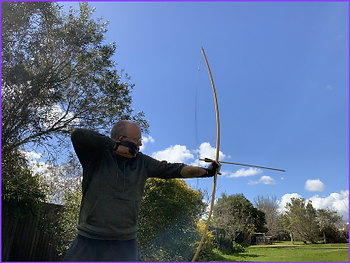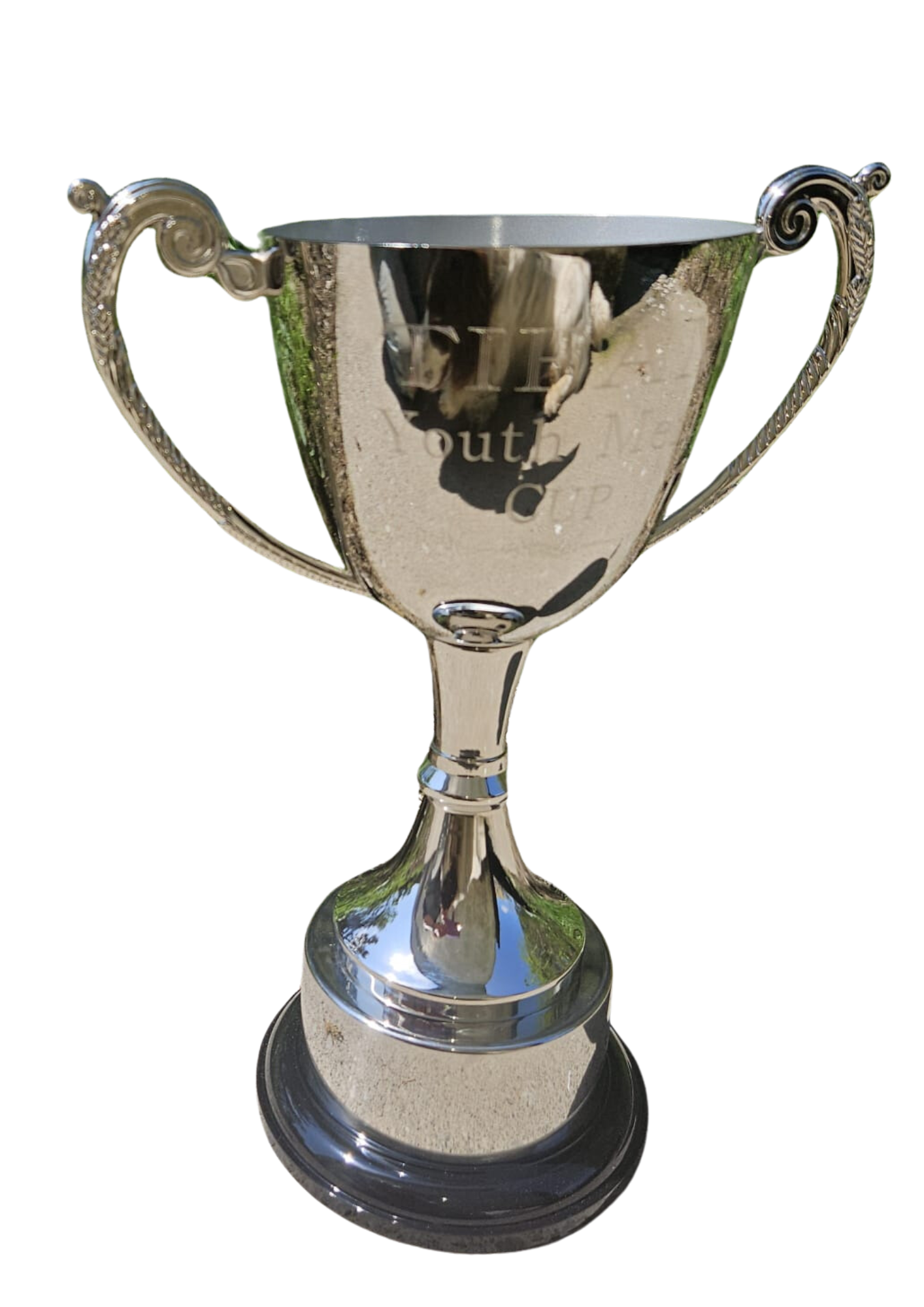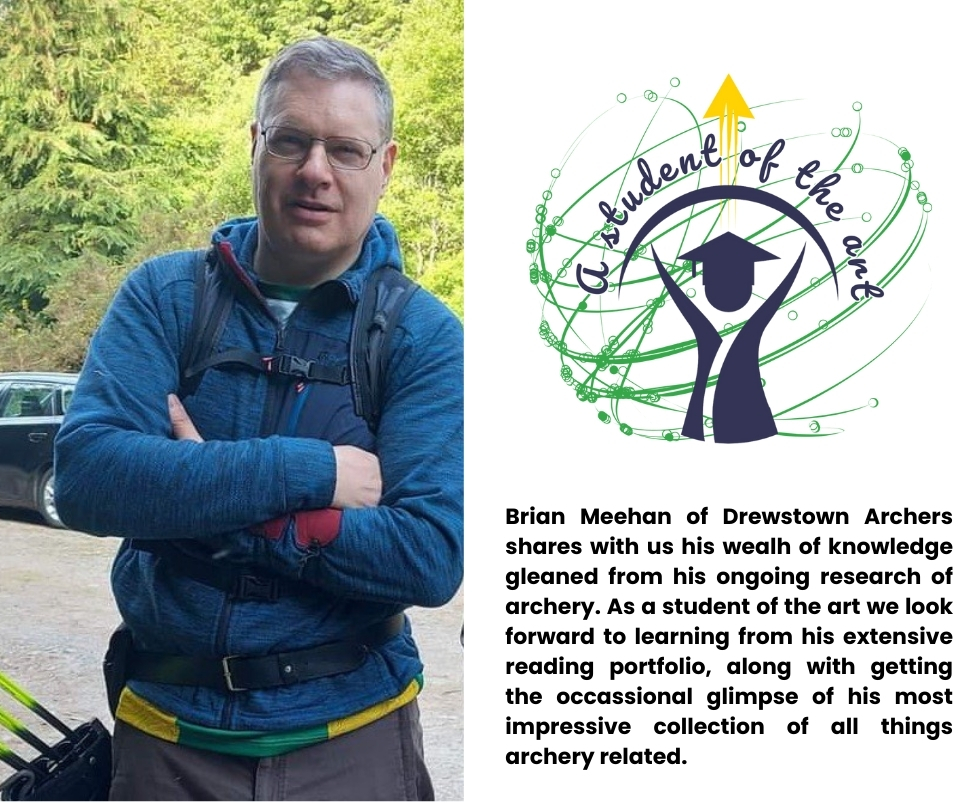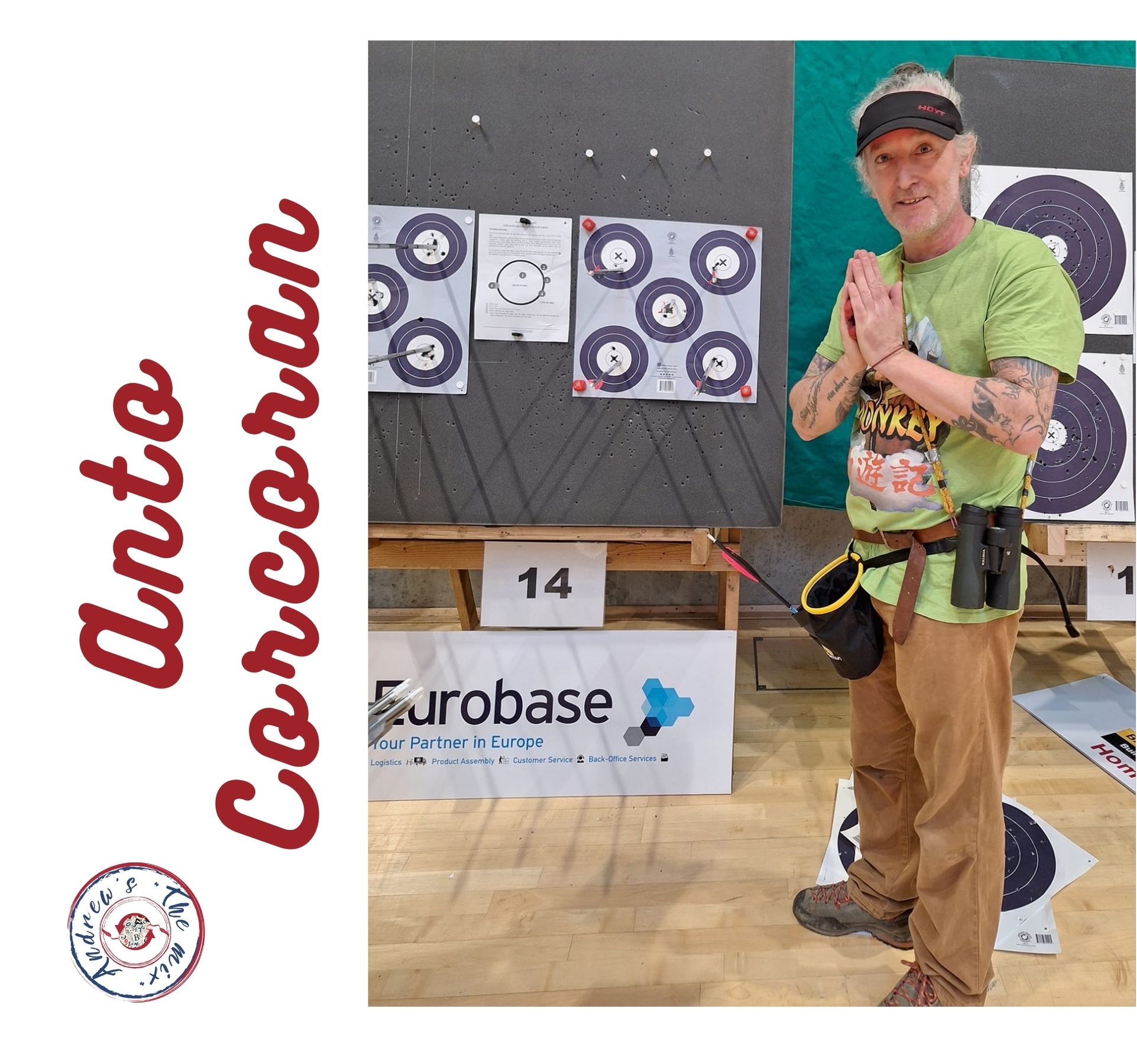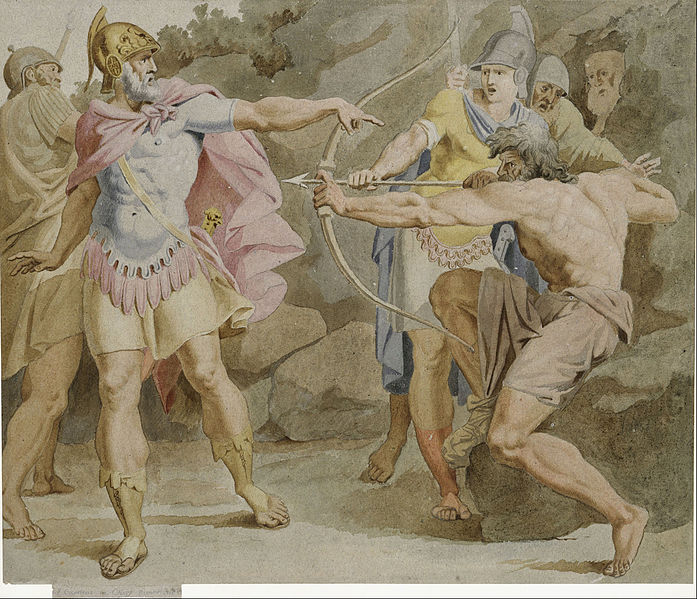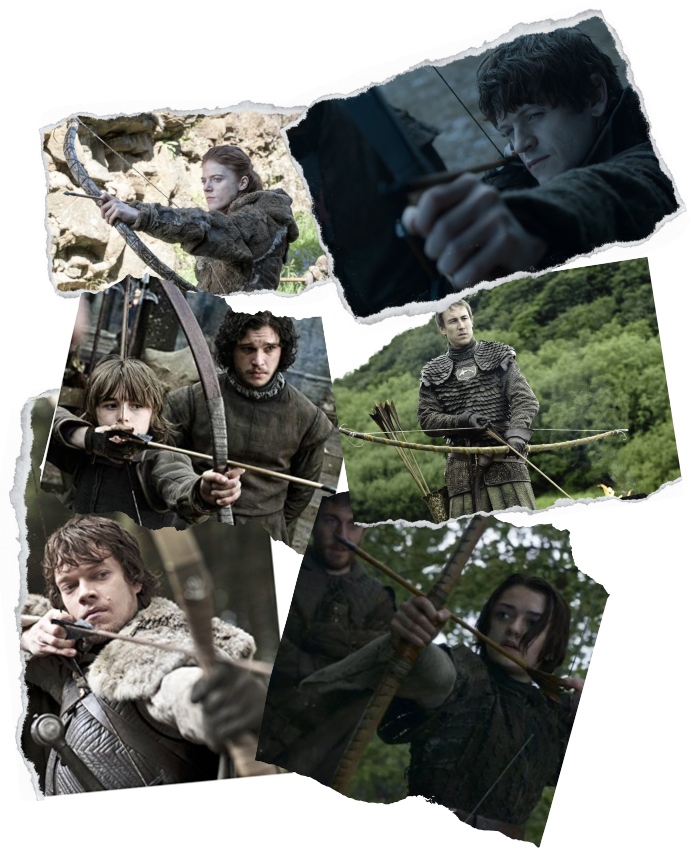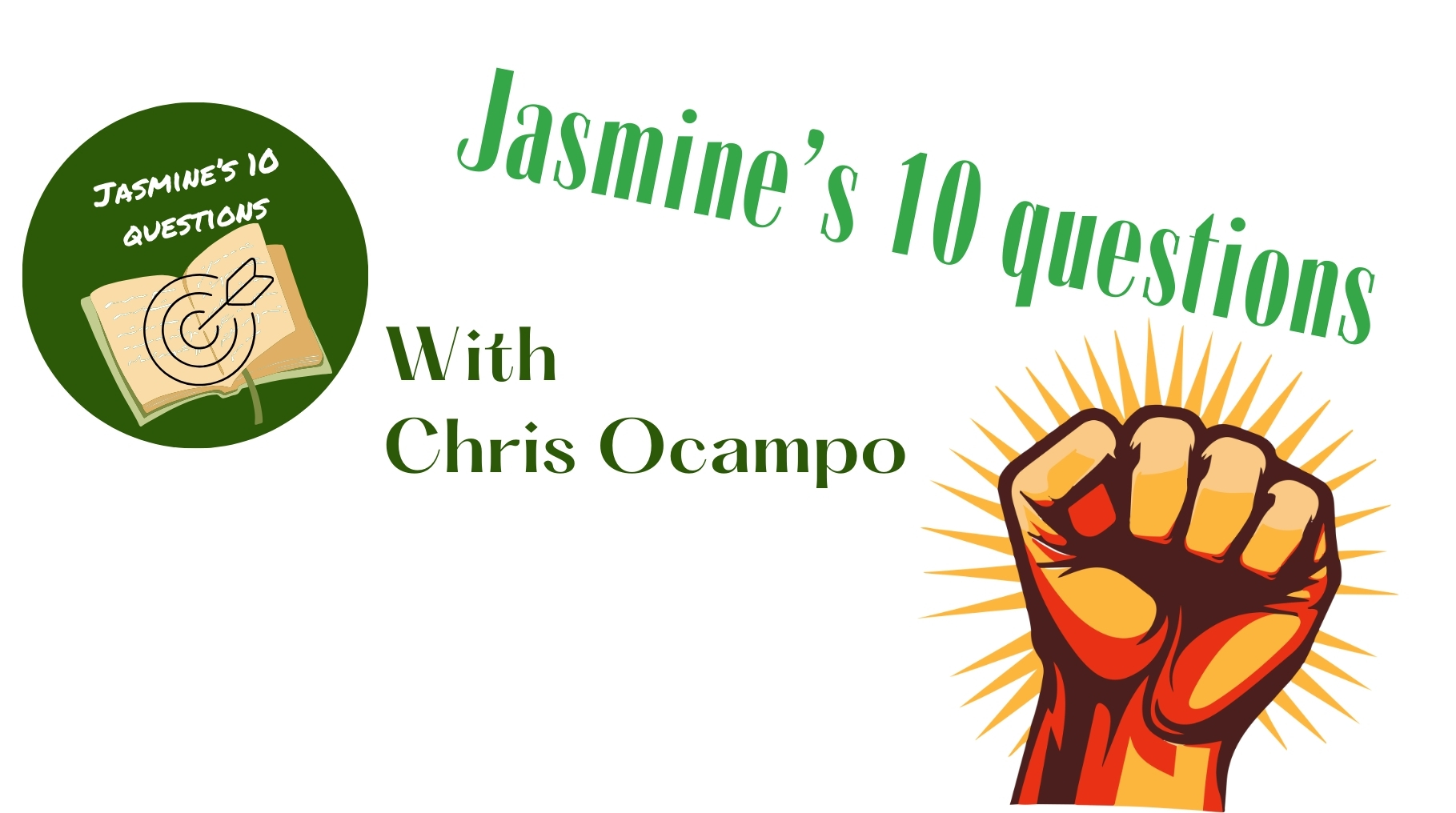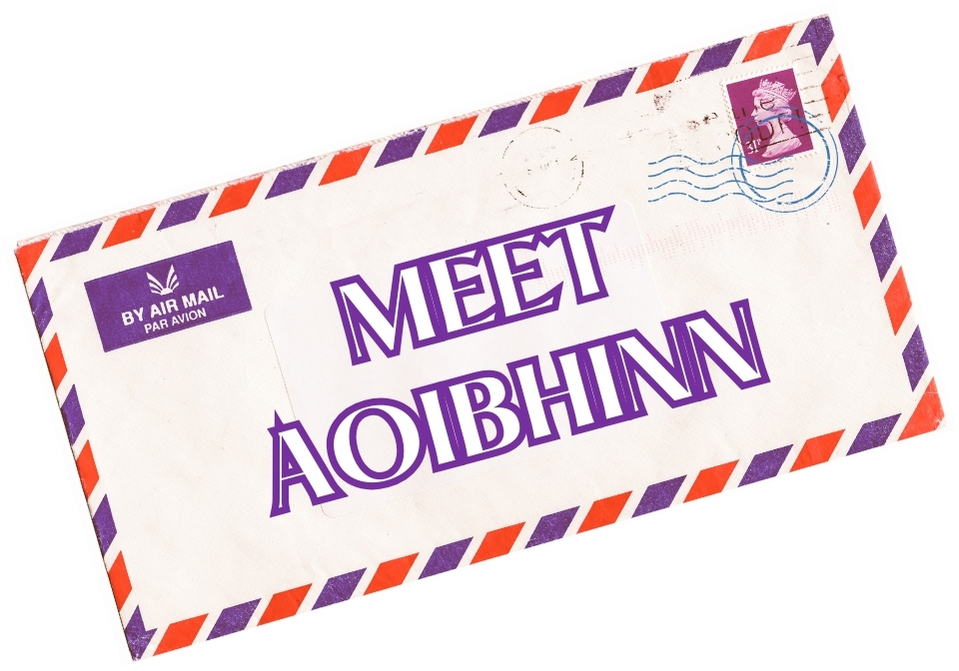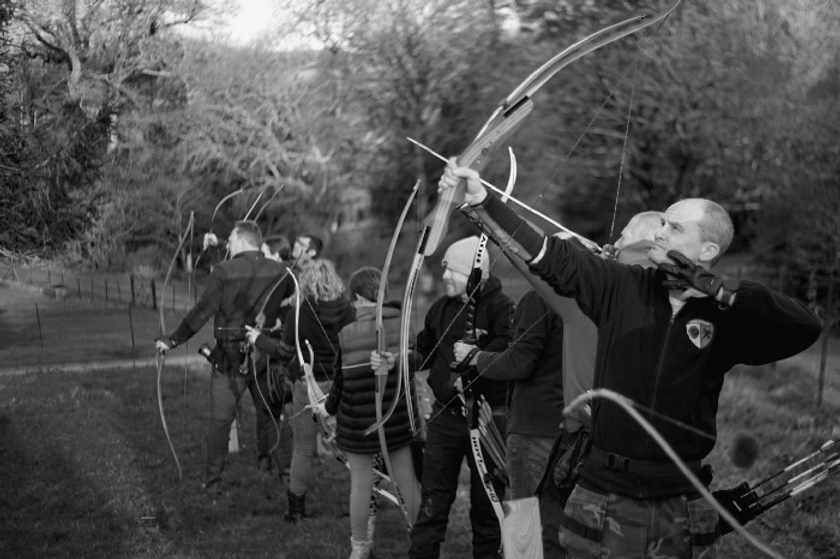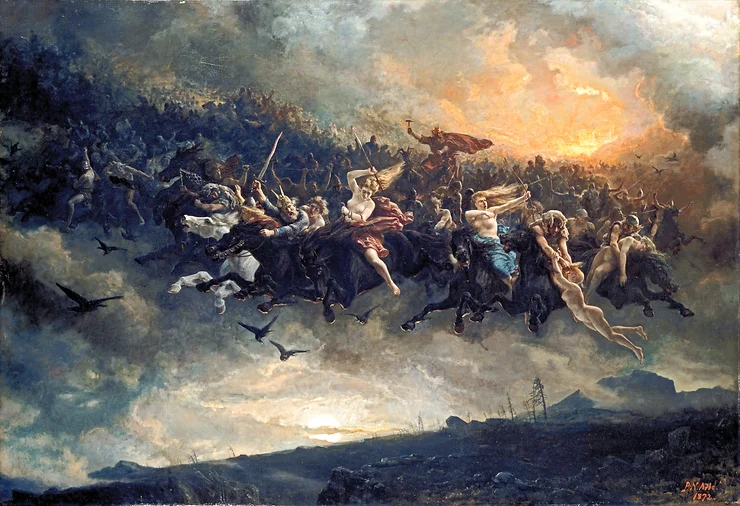
This pursuit encapsulates a thorough exploration of the portrayal of “The Wild Hunt” within the realms of literature, music, and poetry. Consequently, it aligns more with the field of literary studies rather than the confines of a piece suitable for a casual archery magazine. Nevertheless, due to the inherent nature and subject of the myth under scrutiny, my essay holds relevance for the archery community, given its inevitable connection to the venerable elements of the bow and arrows.
The Wild Hunt emerges as a captivating and enigmatic phenomenon deeply ingrained in the folklore and mythology of diverse European cultures. Its most notable association lies within Nordic mythology, yet its influence extends widely, weaving into the beliefs and traditions of various European regions. This exploration delves into its Nordic origins, unravels its profound significance, and traces its impact on popular culture. Additionally, it scrutinizes the theme of the Wild Hunt within the literary realms crafted by renowned authors such as J.R.R. Tolkien, Andrzej Sapkowski, Charles de Lint, Neil Gaiman, and others—highlighting both the striking similarities and nuanced divergences while delving into the sources that inspired their narratives.
The genesis of the Wild Hunt can be traced back to the pre-Christian epochs of Nordic and Germanic realms. This haunting belief revolves around the spectral procession of nightly hunters, accompanied by baying hounds and other supernatural entities. Scholars posit that this mythological motif may have emerged from ancient rituals tied to seasonal cycles and the gathering of sustenance. The Wild Hunt, therefore, emerged as a personification of the forces of nature and the relentless passage of time, reflecting the profound interweaving between human life and the natural world. In Nordic mythology, the enigmatic Odin, the All-Father and principal deity of the Norse pantheon, assumes a central role as the leader of the Wild Hunt. Odin’s elusive persona is encapsulated in the spectral hunt he orchestrates across the night sky, earning him the epithet “Wandering One.” Riding his majestic eight-legged steed, Sleipnir, Odin traverses worlds with a pack of eerie ghostly hounds in tow. During the chase, Odin’s primary task is to collect the souls of fallen warriors, the “Einherjar,” who valiantly met their demise in battle. These heroic souls find their eternal resting place in Valhalla, the majestic hall situated in Asgard, the realm of the gods. The Wild Hunt thus symbolizes the ceaseless cycle of life, death, and rebirth, portraying the heroic journey of fallen warriors to their eternal abode.
While Odin stands as the archetypal leader of the Wild Hunt in Nordic mythology, intriguing variations of the myth emerge across diverse cultures and regions. In some legends, Thor, the formidable god of thunder and humanity’s protector, assumes the mantle of leading the spectral hunt. Alternately, tales exist wherein Freyja, the goddess of love, beauty, and fertility, takes charge of the ethereal procession. These diverse portrayals underscore the adaptive nature of the Wild Hunt myth, seamlessly integrating into the distinct fabric of local folklore.
Functioning as a cautionary tale, the myth symbolizes divine punishment and retribution. Observing the Hunt or hearing its tumultuous sounds was believed to bring catastrophic consequences, ranging from illness to madness or even death. As a precautionary measure, people would remain indoors during the Hunt or leave offerings to appease the spirits and safeguard their homes.
Moreover, across many cultures, the Wild Hunt signifies the thinning of the veil between the living and the spirit world, marking transitional periods between seasons, particularly during the pagan festivals of Yule and Samhain. During these occasions, the belief held that the boundaries between realms blurred, allowing for a deeper connection with the spiritual forces governing nature. Consequently, the Wild Hunt reinforced the significance of seasonal cycles and the acknowledgment of spiritual forces influencing existence.

The captivating and otherworldly imagery of the Wild Hunt has perennially inspired artists, writers, and filmmakers, leaving an indelible mark on creative landscapes. This enduring allure unfolds vividly in the literary realms crafted by esteemed authors like J.R.R. Tolkien, intricately woven into the narratives of “The Silmarillion” and “The Lord of the Rings” trilogy.
At the thematic core is Valar Oromë, revered as the Great Hunter, a prominent figure in Tolkien’s expansive legendarium. Within “The Silmarillion,” Tolkien introduces the Valar, god-like entities shaping the world’s destiny. Oromë, the Huntsman of the Valar, strides across the immortal landscapes of Valinor, embarking on hunts through ancient forests accompanied by magical elven hounds. His horn call, renowned for its beauty and power, heralds the commencement of a Wild Hunt, where the spectral procession of elven hounds follows in ethereal allure. Oromë’s grandeur and the unearthly quality of the Hunt infuse the narrative with mystique.
Tolkien’s portrayal of the Wild Hunt diverges from ominous folklore motifs. Oromë’s hunts embody nobility and providence, symbolizing the untamed beauty of nature and the mysterious forces governing Middle-earth. This resonance extends to “The Lord of the Rings” trilogy, where Legolas, an Elf from Mirkwood, personifies the elven archetype of a skilled archer and huntsman. Legolas’ extraordinary bowmanship and intimate connection with nature deepen the association between Elves and the Wild Hunt motif in Tolkien’s mythos.
In Tolkien’s literary narrative, the Wild Hunt motif serves as a testament to the author’s mastery, infusing his fantasy world with rich mythological elements drawn from diverse folklore traditions. Oromë’s hunts and the spectral elven hounds illuminate the theme of nature’s beauty and the harmonious interplay between the divine and mortal realms.
The motif, intricately linked with Valar Oromë and his ethereal pursuits with elven hounds, elevates the narrative, adding layers of depth and wonder to Tolkien’s masterful works. This thematic richness not only reflects Tolkien’s profound appreciation for mythology but also showcases his unparalleled talent in crafting immersive narratives that captivate readers across generations.

Sapkowski: In his groundbreaking series, “The Witcher,” the Wild Hunt emerges as a defining and haunting element, leaving an indelible mark upon contemporary fantasy literature. Sapkowski adeptly weaves this mythological thread into his gritty and shadow-laden fantasy realm, infusing it with an ominous sense of terror and malevolence.
At the core of the series lies the enigmatic and sinister pursuit orchestrated by Eredin Bréacc Glas, the King of the Wild Hunt. As spectral riders, they traverse the fabric of time and space, leaving behind a trail of devastation and fear. Eredin’s portrayal as a cold and malevolent figure infuses Sapkowski’s interpretation of the myth with mystery, propelling the narrative with urgency and an impending sense of doom.
The protagonist, Ciri, becomes the focal point of the relentless pursuit, her possession of the unique power called Elder Blood heightening the tension and danger woven into the series. Accompanying the Hunt are spectral hounds, known as “the hounds of the chase,” which further contribute to the aura of dread enveloping the spectral riders.
Sapkowski’s portrayal delves into darker themes, offering a reflection of the complex and morally ambiguous world his characters navigate. The reference to the Wild Hunt serves as a symbol of the perpetual struggle between good and evil, where the demarcation between hero and villain blurs, and the consequences of one’s choices carry profound weight.
The gritty and terrifying depiction of the Hunt in “The Witcher” resonates with readers, seizing their imagination and securing its place in the pantheon of contemporary fantasy literature. Furthermore, Sapkowski’s adept incorporation of the chase underscores its adaptability and enduring potency as a timeless and haunting element drawn from folklore and mythology.
As readers continue to traverse the rich and intricate world of “The Witcher,” the Wild Hunt stands as a testament to Sapkowski’s prowess in seamlessly melding ancient traditions with modern storytelling, crafting a literary experience that is not only thrilling but also enduringly captivating.

Charles de Lint: In his contemporary urban fantasy novel, “Moonheart,” the author skillfully integrates the Wild Hunt strain, drawing inspiration from British folklore and Celtic mythology. At the narrative’s core is the mysterious Herne the Hunter, deeply ingrained in British legend, who guides the spectral procession of the Wild Hunt. This aerial procession, a ghostly cavalcade of supernatural beings, transcends the boundaries separating the human world from the ethereal realm.
As the leader of this spectral Hunt, Herne embodies both the majesty and peril associated with this enduring mythological element. The haunting resonance of the chase horns instills fear in those who witness it, and the Hunt’s appearance acts as a harbinger of pivotal moments in the story, catalyzing transformation and self-discovery.
By seamlessly blending ancient myths with the backdrop of contemporary urban life, de Lint explores the enduring power of folklore and its relevance in the modern era. The novel becomes an exploration of the delicate equilibrium between humanity and nature, with Herne serving as a guardian of the natural world. Through the lens of the Wild Hunt, de Lint underscores the intricate interconnectedness of all living beings and the profound consequences that arise from disrupting this delicate balance.
“Moonheart” immerses readers in a realm where age-old legends intersect with the fabric of everyday reality. The fusion of British folklore and Celtic mythology within the narrative adds layers of depth and complexity, inviting readers to embrace the marvel and enigma of ancient myths that resonate and endure in the unfolding narrative of the present.

Neil Gaiman: Reimagines the Wild Hunt as a contemporary and diverse gathering of deities and mythical figures, led by the enigmatic Lord of the World in very curious novel entitled American Gods. In this modern context, the Wild Hunt takes on a new form, reflecting the ever-changing landscape of belief and worship in America. The Lord of the World leads the spectral procession, drawing together a motley crew of ancient gods and mythological beings from various cultures and traditions. These figures, once powerful and revered, have now adapted to the modern world, grappling with their diminishing influence as new deities and beliefs emerge. Gaiman’s portrayal of the Wild Hunt reflects the complexities of belief systems in a diverse society, where gods from different pantheons coexist and interact. The Hunt becomes a symbol of the clash between old and new, traditional and contemporary, as these beings navigate the shifting tides of faith and devotion. Through the Wild Hunt, Gaiman delves into themes of identity, adaptation, and the cyclical nature of belief. The gods’ search for relevance in a changing world mirrors humanity’s quest for purpose and meaning in the face of technological advancements and shifting cultural paradigms. In “American Gods,” Gaiman weaves together a rich tapestry of myths and legends, showcasing the ongoing power of ancient stories in a modern context. The Wild Hunt becomes a captivating embodiment of the complexities of faith, drawing readers into a world where the divine and the mortal converge in a timeless dance of belief and imagination.

Diana Wynne Jones: She encapsulate this mythical motive in her oddly captivating novel “Fire and Hemlock,” where the Wild Hunt emerges as a dangerous and malevolent force, recurring time and again in the narrative. The chase is led by the ominous Lord of the Hunt, who has the power to blur the lines between the mundane world and the supernatural realm. As the Hunt’s leader personifies the relentless pursuit of souls, adding an aura of impending doom to the tale. Through the Wild Hunt, Jones explores themes of destiny, sacrifice, and the consequences of crossing paths with the otherworldly. The haunting presence of the Hunt serves as a potent catalyst for the protagonist’s journey of self-discovery and confrontation with forces beyond mortal comprehension. By this novel Jones showcases her prowess in merging ancient mythological motifs with modern storytelling, creating a gripping and atmospheric narrative that resonates with readers, while also delving into the timeless allure of myths and their persisting impact on the human psyche.

Terry Pratchett: In “Wintersmith” the Wild Hunt takes center stage in a humorous and fantastical manner. Led by the Wintersmith, this spectral procession brings a unique blend of comedy and fantasy to the narrative. Pratchett’s distinctive writing style infuses the Wild Hunt with wit and satire, offering readers a delightful and entertaining experience. The Wintersmith, as the leader of the Hunt, personifies the whimsical and mischievous aspects of the supernatural. Through this comedic portrayal, Pratchett playfully explores the traditional mythological motif, twisting it into a lighthearted and imaginative tale. The Wild Hunt becomes a vehicle for Pratchett’s trademark humor, creating a world where the fantastic and the absurd effortlessly intertwine. Wintersmith exemplifies Pratchett’s unparalleled ability to craft engaging stories that seamlessly blend humor, fantasy, and insightful commentary. In this whimsical adventure, the Wild Hunt becomes a vibrant and comical addition to Pratchett’s rich literary universe.

Patricia Briggs: Through her urban fantasy series “Mercy Thompson,” the Wild Hunt is skillfully referenced, weaving together gods, fae, and formidable supernatural entities. Briggs’s masterful storytelling introduces the phenomenon as an awe-inspiring and unnerving force, led by oracular and almighty figures. The Hunt’s inclusion brings a sense of ancient mythology and mystery to the modern urban setting, blurring the boundaries between the mortal and supernatural realms. By reffering to the Wild Hunt, Briggs explores the intricate dynamics between various supernatural beings, scoping their strengths, rivalries, and alliances. As the spectral procession roams through the series, readers are immersed in a world where gods and fae walk among mortals, creating an atmosphere of suspense and wonder. The Wild Hunt’s presence in the “Mercy Thompson” series adds depth and richness to the urban fantasy narrative, reflecting Briggs’s exceptional ability to blend folklore, mythology, and contemporary themes seamlessly. The juxtaposition of ancient legends with present-day urban life enhances the series, making it an enthralling journey into a world where the boundaries of reality and fantasy become beautifully entangled.

Angela Carter: Midst the pages of her short story “The Erl-King,” the Wild Hunt takes on a dark and eerie persona, delving into the realms of folklore and supernatural terror. Carter’s atmospheric prose transports readers to a haunting and mysterious world, where the Wild Hunt is a malevolent and relentless force. The spectral riders, led by the ambiguous Erl-King, personify the chilling aspects of the Wild Hunt myth, evoking fear and fascination in equal measure. Through vivid imagery and a masterful command of language, Carter paints a haunting picture of the Hunt’s nocturnal pursuit. As the spectral procession weaves through the story, the lines between reality and the supernatural blur, leaving readers spellbound by the unsettling atmosphere. “The Erl-King” showcases Carter’s unique ability to intertwine traditional folklore with her signature blend of gothic and feminist themes. The Wild Hunt becomes a vehicle for exploring the darker aspects of human nature, as well as the tenuous boundaries between the natural and supernatural worlds.

Marion Zimmer Bradley: Bradley’s epic novel “The Mists of Avalon,” depicts the Wild Hunt as it emerges as an integral element of the Arthurian legend, adding a mystical and otherworldly dimension to the iconic tale. Drawing inspiration from Celtic mythology, Bradley weaves the Wild Hunt into the fabric of the Arthurian narrative. The spectral procession becomes a symbol of fate and destiny, sweeping across the land with an air of foreboding. Through her evocative prose, Bradley captures the essence of the Wild Hunt as an omen of change and transformation. As the spectral riders traverse the mists, they herald momentous events that shape the lives of Arthur and his kingdom, echoing the cyclical nature of life and the passing of time. Incorporating Wild Hunt Myth into “The Mists of Avalon” enriches the novel’s mystical undertones, bringing the reader into a world where ancient folklore and Arthurian legend converge. The chase becomes a potent metaphor for the forces that shape human lives and the mysterious ways in which destiny unfolds. Bradley’s masterful blending of myth and history breathes new life into the Arthurian legend, infusing it with a sense of wonder and mystery. By incorporating the Wild Hunt, she adds a touch of the supernatural to an already captivating tale, making “The Mists of Avalon” a timeless and enchanting exploration of the human experience within the framework of myth and legend.

Richard Wagner: The Wild Hunt makes an unforgettable appearance in Richard Wagner’s “Die Walküre,” a masterpiece in his epic opera cycle “Der Ring des Nibelungen.” The “Ride of the Valkyries” scene is a stunning depiction of the mythic chase, with the Valkyries at the forefront as Odin’s warrior maidens. Their job is to lead the procession of fallen heroes to Valhalla, the hall of the slain. Wagner’s musical and dramatic interpretation of the Wild Hunt is an awe-inspiring spectacle that combines powerful elements of myth and storytelling. The Valkyries’ arrival on the battlefield is announced by the electrifying surge of the orchestra’s music, a triumphant motif that has become an iconic component of the scene. Mounted on majestic horses, they descend with a sense of urgency, embodying their duty to collect the souls of the brave warriors who have fallen in battle. The scene is imbued with a poignant mixture of mourning and reverence as the Valkyries collect the fallen heroes, emphasizing the valour and honour of those who have met their demise in battle. Wagner’s portrayal of the Wild Hunt as a spectral procession of noble warriors emphasizes the themes of heroism, sacrifice, and the transcendent power of myth. The Valkyries’ task of guiding the fallen to their eternal resting place in Valhalla (as a conductors of death) becomes the overriding theme, common to all mythologies regardless of time and place, underscoring the eternal cycle of life, death, and rebirth. The Wild Hunt also serves as a symbol of the eternal struggle between mortals and the divine, between bravery and fate. The Valkyries’ ethereal presence bridges the gap between the mortal world and the divine, adding a layer of complexity to the scene and elevating it to a level of profound mythic resonance.
Of course, given the utilitarian nature of the plot of “Wild Hunt,” unflinchingly we find traces of it in the works of many poets, which once again bears witness to the power of influence and rooting in culture over the centuries. Indeed, it is one of these myths that are the pillars of not only modern culture, but are the bedrock of all civilization from its inception to the present day. Here are a few examples of poetry that incorporate the Wild Hunt motif:
“The Wild Huntsman” by Johann Ludwig Uhland:

German poet, penned the ballad “Der wilde Jäger” or “The Wild Huntsman,” which vividly portrays the haunting and spectral nature of the Wild Hunt. The poem tells the story of a huntsman who encounters the Wild Hunt while wandering in the woods. The poem’s atmospheric descriptions and melancholic tone capture the sense of foreboding and mystery associated with the myth.
Excerpt:
“When o’er the hills the hoary Night
Her mantle dark doth throw,
Then wake the sounds of chase and flight,
And the hunter’s horn we blow.”
“The Wild Hunt of Odin” by Robert Graves:
Renowned poet Robert Graves explores the Chase in his poem “The Wild Hunt of Odin,” which draws from Norse mythology. The poem vividly describes Odin’s spectral hunt through the night sky, emphasizing the awe-inspiring and terrifying aspects of the phenomenon.
Excerpt:
“Under the ash-tree goes and comes
A figure wrapped in a brown mantle,
Hooded, hidden as are the eyes of a raven.”
“The Wild Hunt” by Charles G.D. Roberts:
Canadian poet Charles G.D. Roberts delves into the mythic and supernatural in “The Wild Hunt.” The poem portrays the spectral hunt as a malevolent and chaotic force that disturbs the natural world. The vivid imagery and rhythmic language create a sense of urgency and danger.
Excerpt:
“In ghastly glee they sweep,
Past the trees’ moan and shiver;
On the moon’s track, the course they keep;
Nor rest have they, nor respite, deep
In the crystal gulfs of the river.”
“Huntress of the Wild” by Clark Ashton Smith:
Clark Ashton Smith, known for his works in fantasy and horror, explores the theme of the Wild Hunt in “Huntress of the Wild.” The poem weaves a tale of a spectral huntress who rides through the night, and the vivid imagery captures the eerie and mysterious nature of the Hunt.
Excerpt:
“The wolves that follow are no earthly pack,
No hounds of sylvan kindred; they are black,
Infernal, phantom, seen of eyeless men
Who hear no howl, and hear but once again
The sound of midnight on the forest track.”
“The Wild Hunt” by Henry Kendall:
Australian poet Henry Kendall –
harnesses the concept in his poem “The Wild Hunt.” The poem portrays the spectral hunt as a tumultuous force that sweeps through the night sky, evoking a sense of wonderment and marvel.
Excerpt:
“And the wheels go round, and the night falls down,
As a stone goes down to the sea;
And the Star of the North is the Star of a Crown,
And the Hunt is riding free.”
“Wild Huntsman” by Emily Dickinson:
Emily Dickinson, known for her enigmatic and introspective poetry, captures the essence of the Wild Hunt in her succinct poem “Wild Huntsman.” The poem alludes to the mysterious and unstoppable nature of the hunt.
Excerpt:
“Wild nights – Wild nights!
Were I with thee
Wild nights should be
Our luxury!”
“The Wild Hunt” by Sara Teasdale:
American poet Sara Teasdale presents a vivid and sensory depiction of the Chase in her poem “The Wild Hunt.” The poem describes the tumultuous and otherworldly hunt, drawing readers into its ethereal realm.
Excerpt:
“Like ghosts in the moonlight
When the white mists swirl,
The Wild Host of Odin
Rides through the world.”
“The Wild Hunt” by Seosamh Mac Grianna:
Irish poet Seosamh Mac Grianna explores the Wild Hunt in his poem “The Wild Hunt,” drawing from Celtic folklore. The poem nearly lifelike portrays the hunt’s arrival and departure, capturing the spectral and haunting attributes of the myth.
Excerpt (translated):
“And the thunder of their horses’ hooves on the turf,
When they are late back to the bristly sea:
Then will the red sea burst its bounds,
In frenzy, with great waves.”
“The Wild Hunt” by Fiona Macleod (William Sharp):
Under the pseudonym Fiona Macleod, William Sharp penned a poem titled “The Wild Hunt,” which weaves Celtic mythology into the motif. The poem conveys the idea of the Wild Hunt as a spectral procession led by supernatural entities.
Excerpt:
“When the last faint far light
Of the fires of the night
Through the glimmering mist and the murk
Fades into the grey of the morning:
O then, from the mountains, the valleys,
The shore and the main,
Wild Riders, Wild Hunters, Wild Horses, Wild Men,
Like the spears of the rain
Swept down by the blast, over furrow and fen,
Shall vanish, as in a dream,
Out of sight and out of life.”

Goethe’s poetic exploration of the Erl-King in “Der Erlkönig” is firmly entrenched in the ancient and enduring myth of the Wild Hunt, a motif that has woven its spectral threads through the tapestry of various European folklores. This tale, resonating with themes of death and otherworldly forces, has transcended time, manifesting in diverse cultural expressions. Its profound influence is unmistakably palpable in Goethe’s nuanced portrayal of the Erl-King.
The poem masterfully intertwines strands of the Wild Hunt myth, crafting a narrative that is both haunting and laden with symbolism. Within this poetic fabric, diverse tropes, inspired by the ethereal pursuits of the Wild Hunt, emerge with evocative potency:
The Erl-King, an ominous figure, doggedly pursues the young boy and his father through the forest, casting an aura of urgency and inevitability. This relentless chase metamorphoses into a profound metaphor for the inexorable approach of death. The eerie ambiance of the forest and the Erl-King’s sudden, ghostly apparition contribute to an atmosphere of otherworldly encounter. This thematic underpinning adds an enigmatic quality, emphasizing the blurred boundaries between the realms of life and death.
Here, the Erl-King assumes the mantle of a symbolic figure representing death itself. The poem delves into the psychological and emotional impact of mortality, particularly through the vulnerable lens of a child facing the imminent threat of the Erl-King’s impending embrace.
Often shrouded in fascination and terror, WIld Hunt represents nothing more nor less than the allure of the unknown. Analogously, the Erl-King in Goethe’s verses entices the boy with promises of mysterious landscapes and spectral companions. The poem becomes a poignant exploration of the human fascination with the enigmatic and the perilous allure of venturing into uncharted territories.
While not overtly present in traditional Wild Hunt mythology, the intricate father-son dynamic in Goethe’s poem introduces a unique layer to the narrative. The father’s dismissal of the boy’s perception of the Erl-King hints at a generational gap, accentuating the perennial struggle between innocence and the harsh dictates of experience.
The nomenclature “Erlking” (Erlkönig in German) finds its roots in the mosaic of German Romanticism, embodying the essence of a spectral being, a sovereign ruler of the fairy realm. It is believed to have originated from the Danish folklore’s ellekonge or elverkonge, signifying the “Elf-king” in days of yore. The name made its inaugural appearance in Johann Gottfried Herder’s ballad “Erlkönigs Tochter” in 1778, an adaptation of the Danish Hr. Oluf han rider from 1739. Subsequently, Johann Wolfgang von Goethe embraced this spectral entity in his poetic masterpiece “Erlkönig” in 1782, a composition later enshrined in musical resonance by Schubert and others. Notably, Goethe added a novel layer of interpretation, as “Erl” ceased to denote an elf but rather the “black alder,” situating the narrative in the alder-laden expanse of the Saale valley in Thuringia. In English renditions of Goethe’s verse, the name occasionally morphs into Erl-king.
Alternative conjectures have surfaced over time; in 1836, Halling proffered an association with Erlik Chan, a deity of death or psychopomp in Turkic and Mongolian traditions.
The inception of this enigmatic character into German literary annals is attributed to Johann Gottfried von Herder’s “Erlkönigs Tochter,” a ballad immortalized in his 1778 collection Stimmen der Völker in Liedern. Derived from the Danish folk ballad “Hr. Oluf han rider” in Danske Kæmpeviser (1739), Herder’s rendition underwent a transformation where the Danish elvermø (“elf maid”) metamorphosed into Erlkönigs Tochter. In Danish lore, ancient burial mounds were believed to be the abode of elverkonge, colloquially elle-r-konge, a term later misinterpreted in Denmark as the “alder king,” drawing a curious parallel with the Germanic alder tree.
The narrative woven by Herder unfurls the tale of Sir Oluf, bound for matrimonial vows but ensnared by the ethereal melodies of the elves. An elf maiden, in Herder’s interpretation the progeny of the Elverkonge, materializes and extends an invitation to dance. His rejection of her entreaties and disdain for her gifts elicit her wrath, culminating in a malevolent strike that leaves him pallid and lifeless. As the dawn breaks on the day of his intended union, his betrothed discovers him lifeless beneath his scarlet cloak, a haunting tableau of the Erl-King’s spectral vengeance.
Jacob Grimm traces the genesis of the term “Erl-King” to the Scandinavian lexicon, specifically the Danish “ellekonge,” denoting the monarch of elves, or the female counterpart, “elverkongens datter,” signifying the elven king’s daughter. This spectral figure, according to Grimm, assumes the role of ensnaring unsuspecting human beings, driven by desires that traverse the realms of envy, lust, and a vengeful thirst. An ethereal enchantress, she crafts a narrative of enthrallment.
In consonance with Grimm’s elucidation, The New Oxford American Dictionary portrays the Erl-King as a bearded giant or goblin, a malevolent entity that entices innocent children toward the realms of death. A misstep in translation occurred in the late 18th century when Herder, swayed by the allure of language, mistakenly rendered it as “Erlkönig” instead of the original “ellerkonge.” The accurate German nomenclature would have been “Elbkönig” or “Elbenkönig,” later transfigured into the modified form of “Elfenkönig” by Christoph Martin Wieland in his 1780 poem “Oberon.”
Goethe, although inspired by Herder’s ballad, embarked on a departure that echoed significantly from both Herder’s rendition of the Erl-King and the Scandinavian archetype. In Goethe’s “Der Erlkönig,” the malevolent force becomes the Erl-King himself, diverging from the paternal antagonist presented by Herder. The Erlkönig materializes to a feverish, delirious young boy, a vision dismissed by the boy’s father as a mere streak of fog. Goethe’s Erl-King deviates further, preying not on adults of the opposite sex but on innocent children, and the motivations cloaking his sinister deeds remain shrouded in enigma. Goethe’s Erl-King, in essence, aligns more closely with the Teutonic representation of elves and valkyries—a harbinger of death rather than a mere magical spirit.
In Angela Carter’s evocative short story “The Erl-King,” nestled within the pages of the 1979 collection “The Bloody Chamber,” the female protagonist finds herself entwined with a malevolent forest spirit. Despite her awareness of his nefarious intentions, she becomes ensnared in a dilemma, torn between the allure of desire and the yearning for freedom. Ultimately, she concocts a plan to extinguish his life, a desperate bid to liberate herself from the clutches of his enchanting power—an echoing narrative that resonates with the haunting strains of the Erl-King’s siren song.
In Vladimir Nabokov’s 1962 novel, “Pale Fire,” Charles Kinbote, the intricate narrator, weaves subtle allusions to “alderkings.” One such reference emerges in his commentary in line 275 of John Shade’s eponymous poem. In this instance, the term evokes the specter of ancestral figures, steeped in a clandestine realm of homosexuality, intricately linked to the final monarch of Zembla—Kinbote’s professed homeland. Throughout the novel, Kinbote sprinkles the narrative with additional mentions of these enigmatic alderkings, adding layers of mystery and cultural nuance.
Within Jim Butcher’s “The Dresden Files,” a character christened the Erl-King strides onto the literary stage, a creation modeled after the formidable leader of the Wild Hunt, Herne the Hunter. Butcher weaves a tapestry of fantasy where this Erlking reigns, embodying the primal essence of the hunt and the untamed.
John Connolly’s short story collection, “Nocturnes” (2004), introduces a character known as the Erl-King, who weaves a dark tale of attempted abduction in his pursuit of the protagonist. The Erlking emerges as a haunting figure, symbolizing the intersection of the supernatural and mortal realms.
Zoe Gilbert, in “Mischief Acts,” ventures into the mythic with a mention of a version of the Erl-King, entwined with the mysterious Herne the Hunter. This subtle reference adds an intriguing layer to Gilbert’s narrative, blending folklore with modern storytelling.
The Erl-King
(Johann Wolfgang von Goethe)
Who rides there so late through the night dark and drear?
The father it is, with his infant so dear;
He holdeth the boy tightly clasp’d in his arm,
He holdeth him safely, he keepeth him warm.
“My son, wherefore seek’st thou thy face thus to hide?”
“Look, father, the Erl-King is close by our side!
Dost see not the Erl-King, with crown and with train?”
“My son, ’tis the mist rising over the plain.”
“Oh, come, thou dear infant! oh come thou with me!
Full many a game I will play there with thee;
On my strand, lovely flowers their blossoms unfold,
My mother shall grace thee with garments of gold.”
“My father, my father, and dost thou not hear
The words that the Erl-King now breathes in mine ear?”
“Be calm, dearest child, ’tis thy fancy deceives;
‘Tis the sad wind that sighs through the withering leaves.”
“Wilt go, then, dear infant, wilt go with me there?
My daughters shall tend thee with sisterly care
My daughters by night their glad festival keep,
They’ll dance thee, and rock thee, and sing thee to sleep.”
“My father, my father, and dost thou not see,
How the Erl-King his daughters has brought here for me?”
“My darling, my darling, I see it aright,
‘Tis the aged grey willows deceiving thy sight.”
“I love thee, I’m charm’d by thy beauty, dear boy!
And if thou’rt unwilling, then force I’ll employ.”
“My father, my father, he seizes me fast,
Full sorely the Erl-King has hurt me at last.”
The father now gallops, with terror half wild,
He grasps in his arms the poor shuddering child;
He reaches his courtyard with toil and with dread,–
The child in his arms finds he motionless, dead.
(Translated by Edgar A. Bowring, 1853)
Some posit that romanticism is akin to a malady of the soul, a delicate affliction that befalls those enchanted by its allure—a fragile state destined for ephemeral existence. However, I propose that we enter this world already infused with its essence, a contamination intrinsic from the outset, lying dormant until Goethe’s verses gracefully unfurl before our discerning eyes.
The Erl-King, possessing an irresistible allure, appears as a manifestation drawn from the wellspring of ancient folk tales or the soft murmurs of grandmothers beside our beds on dark, rain-soaked nights—warding off unseen creatures lurking in the shadows, mysterious and elusive.
Contrary to prevailing beliefs, romanticism is far from a forsaken, tedious literature relegated to the dusty archives of academia, discussed solely by pipe-smoking, grey-bearded scholars in ivy-covered halls. Narratives like Erl-King have silently accompanied us since childhood, quietly shaping the foundations of our being.
The tale unfolds: a father galloping through the night with his son, the child gripped by fears of whispering apparitions, the father oblivious to the son’s dread—a blind old man juxtaposed with an all-seeing boy. Is this not the perfect allegory for the intricate dance of familial bonds? Ultimately, the Erl-King mirrors our own journey—through the shadows, into a light concealed behind the impenetrable veil of the dense forest.
Woods, nature, the rhythmic gallop of a horse, and the surge of untamed emotions—all converge into a hereditary affliction, unwittingly passed through the corridors of generations, an ancestral legacy of which we are both heirs and bearers. The eternal chase through our lives, constructed brick by brick on the foundation of myths and lore, echoes with the resonance of the Erl-King. We have all been both chased and the chaser, and perhaps today we embody the essence of the Earl-king, acknowledging our pursuit of youth in this mad, wild chase through a world, like a charmed child, resisting until our mutual destruction.




